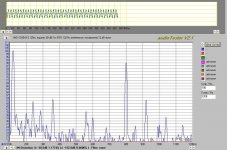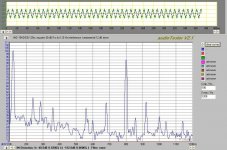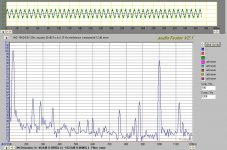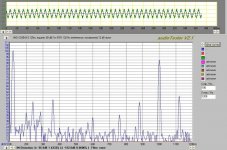BTW so I did an IMD comparison between 15ND930 and SS8543. I didn't quite know what to choose but thought, 120 Hz is more useful than the usual 60 Hz because it is present both as hum and as music. Else I went with default, i.e. the interference signal is a full 12 dB louder than the test signal (400, 800 or 1000 Hz). I think it's tough test anyway. Result is again, no replacement for displacement. At 90 dB/1m interference signal and 78 dB for the test signal, the 15ND930 was slightly better in all cases, both hovering at 0.9-1.2% IMD or so. But at any higher levels, IMD for the smaller woofer could easily jump to 5%.
Here is the SS8543 at 800 Hz.
Here is the SS8543 at 800 Hz.
Attachments
Member
Joined 2003
HOM supposedly occurs only at high levels, so the pulse comparison is a fairly stressful test because pulse is so loud (probably lethal for dome tweeter). For a while, microphone was a concern. Dunno SPL, but it is louder than driver is ever used for listening . There seems to be correlation between waveform distortion and energy storage which is one of the things I need to explore further.
. There seems to be correlation between waveform distortion and energy storage which is one of the things I need to explore further.
Have you compared 2-tone distortion for the 15ND930 and SS8543 with both signals near XO frequency for 2-way with waveguide?
 . There seems to be correlation between waveform distortion and energy storage which is one of the things I need to explore further.
. There seems to be correlation between waveform distortion and energy storage which is one of the things I need to explore further.Have you compared 2-tone distortion for the 15ND930 and SS8543 with both signals near XO frequency for 2-way with waveguide?
Yes, I have. The nearfield FR 15ND930 starts showing aberrations starting at 1.2k so I kept the highest test at 1000 Hz, attached.
(The farfield is OK until ca. 1.5k when the breakup takes off and I would think 1.2-1.3k XO is feasible, but the testing is harder to do there because farfield introduces a lot of "special effects" so I kept it at 1k).
(The farfield is OK until ca. 1.5k when the breakup takes off and I would think 1.2-1.3k XO is feasible, but the testing is harder to do there because farfield introduces a lot of "special effects" so I kept it at 1k).
Attachments
SS8543.
Bottom line is that IMD just like THD for both drivers is fairly constant over a wide range, and depends mainly on level. And here the 8543 suffers first, and in IMD more severely, than the 15ND930.
BTW I fiddled with CSD but I don't think it is feasible unless I use a large, special baffle. THe usual time slices are in the ms range, and that is exactly the time frame it takes for the dipole rear wave to come around the front baffle. So I get practically no decay at all (unless, quite possible, that I did a major blunder).
Bottom line is that IMD just like THD for both drivers is fairly constant over a wide range, and depends mainly on level. And here the 8543 suffers first, and in IMD more severely, than the 15ND930.
BTW I fiddled with CSD but I don't think it is feasible unless I use a large, special baffle. THe usual time slices are in the ms range, and that is exactly the time frame it takes for the dipole rear wave to come around the front baffle. So I get practically no decay at all (unless, quite possible, that I did a major blunder).
Attachments
Really, REALLY great thread...
As far as combining a 12" or 15" midrange with a compression driver, what are some feasible options for horns/ waveguides which will afford a smooth transition in directivity in the 1.2k to 2khz crossover range?
Obviously, the DDS waveguide seems reasonable, but how about one of the ubiquitious round Tractrix horns? John Sheerin posted some polar response maps, and generally characterized them here: "Based on a few simulations, it looks like tractrix horns with no mouth termination (like Bruce Edgar makes) have a slightly bumpy power response going from ~60 degrees at relatively high frequencies (10x the flair frequency) to 100-120 degrees about 1 octave above the flair frequency. Around ~1.5x the flair frequency, the pattern narrows a bit and then opens way up to be around 280 degrees at the flair frequency - almost omni-directional."
So, any thoughts on whether or not one could crossover from a 12" midrange to a 1" compression driver on, say, a 800hz tractrix at 1.6khz and have some continuity in directivity?
I think that probably the poor power response at higher frequencies with tractrix horns might be a problem, but again I'm not sure. Any thoughts?
Regards,
John
As far as combining a 12" or 15" midrange with a compression driver, what are some feasible options for horns/ waveguides which will afford a smooth transition in directivity in the 1.2k to 2khz crossover range?
Obviously, the DDS waveguide seems reasonable, but how about one of the ubiquitious round Tractrix horns? John Sheerin posted some polar response maps, and generally characterized them here: "Based on a few simulations, it looks like tractrix horns with no mouth termination (like Bruce Edgar makes) have a slightly bumpy power response going from ~60 degrees at relatively high frequencies (10x the flair frequency) to 100-120 degrees about 1 octave above the flair frequency. Around ~1.5x the flair frequency, the pattern narrows a bit and then opens way up to be around 280 degrees at the flair frequency - almost omni-directional."
So, any thoughts on whether or not one could crossover from a 12" midrange to a 1" compression driver on, say, a 800hz tractrix at 1.6khz and have some continuity in directivity?
I think that probably the poor power response at higher frequencies with tractrix horns might be a problem, but again I'm not sure. Any thoughts?
Regards,
John
Interesting point and good link info...
There are two ways going about this:
- trying to match the theoretical dipole pattern, for maximum power response flatness. This means, crossing anywhere up to the point where the woofer/mid loses its -6dB @ 60 degrees pattern. Say for my 15" this would be ca. 1200 Hz. The Tractrix seems to have too narrow a pattern, but the Le Cleac'h might do the trick
- accepting to take the woofer even higher, and match radiation patterns in a range where the woofer itself becomes directional. Geddes does this in the Summa, in fact he uses a large woofer specifically for polar control in a monopole setup, and thus getting directionality at a lower 900 Hz. For my 15" dipole setup however this would not be a good option, because it holds 60 degree off axis pattern right into 1.3-1.4k when the breakup modes set in. In Paul's case, the 12" being better behaved, he can pick and choose which radiation pattern he wants to at HF.
But other things should be considered as well. The main advantage of low loading, shallow waveguides (and specifically, either Geddes' oblate spheroid or Peavey's quadratic) apparently generate fewer "higher order modes" (HOM), i.e., internal reflections, which Geddes blames for generating hornish sound and reduced openness. The trade-off of lower loading should be acceptable for a domestic setting.
There are two ways going about this:
- trying to match the theoretical dipole pattern, for maximum power response flatness. This means, crossing anywhere up to the point where the woofer/mid loses its -6dB @ 60 degrees pattern. Say for my 15" this would be ca. 1200 Hz. The Tractrix seems to have too narrow a pattern, but the Le Cleac'h might do the trick
- accepting to take the woofer even higher, and match radiation patterns in a range where the woofer itself becomes directional. Geddes does this in the Summa, in fact he uses a large woofer specifically for polar control in a monopole setup, and thus getting directionality at a lower 900 Hz. For my 15" dipole setup however this would not be a good option, because it holds 60 degree off axis pattern right into 1.3-1.4k when the breakup modes set in. In Paul's case, the 12" being better behaved, he can pick and choose which radiation pattern he wants to at HF.
But other things should be considered as well. The main advantage of low loading, shallow waveguides (and specifically, either Geddes' oblate spheroid or Peavey's quadratic) apparently generate fewer "higher order modes" (HOM), i.e., internal reflections, which Geddes blames for generating hornish sound and reduced openness. The trade-off of lower loading should be acceptable for a domestic setting.
Member
Joined 2003
Thanks for the links!
When simulating Tractrix with Hornresp, my conclusion was that they beamed too much at HF...of course many people use them so they can't be too bad.
Here are a few shots from this weekend comparing the DDS Eng 90 with the 12"/$7 MSC waveguides modified for the BMS 4552ND bolt-on drivers. Don't know what profile the "cheapies" represent, but it seems like an exponential flare in a round format. (Note that the throat is actually about 1 1/8" so there could be a throat mismatch with 1" screw-on drivers.)
You can draw your own conclusions, but directivity for a 1.2-2k XO seems adequate.
First, the cheapie 12" at 0-15-30-45-60 degrees, 0.5M from throat.
DDS 0-15-30-45-60 degrees.
12" CSD at mouth
DDS CSD at mouth
12" RTA at about 10' (including all room & furniture reflections)
DDS RTA
If you decide to use the dipole approach to control midrange directivity, then the rear radiation/rear tweeter question comes to mind. My speakers are too close to the front wall, so the current approach is to absorb the upper midrange rear radiation and use only a forward firing tweeter.
When simulating Tractrix with Hornresp, my conclusion was that they beamed too much at HF...of course many people use them so they can't be too bad.
Here are a few shots from this weekend comparing the DDS Eng 90 with the 12"/$7 MSC waveguides modified for the BMS 4552ND bolt-on drivers. Don't know what profile the "cheapies" represent, but it seems like an exponential flare in a round format. (Note that the throat is actually about 1 1/8" so there could be a throat mismatch with 1" screw-on drivers.)
You can draw your own conclusions, but directivity for a 1.2-2k XO seems adequate.
First, the cheapie 12" at 0-15-30-45-60 degrees, 0.5M from throat.
An externally hosted image should be here but it was not working when we last tested it.
DDS 0-15-30-45-60 degrees.
An externally hosted image should be here but it was not working when we last tested it.
12" CSD at mouth
An externally hosted image should be here but it was not working when we last tested it.
DDS CSD at mouth
An externally hosted image should be here but it was not working when we last tested it.
12" RTA at about 10' (including all room & furniture reflections)
An externally hosted image should be here but it was not working when we last tested it.
DDS RTA
An externally hosted image should be here but it was not working when we last tested it.
If you decide to use the dipole approach to control midrange directivity, then the rear radiation/rear tweeter question comes to mind. My speakers are too close to the front wall, so the current approach is to absorb the upper midrange rear radiation and use only a forward firing tweeter.
Thanks for the replies; there's definitely a lot to try and wrap your arms around in terms of smoothly moving from a large diameter dipole to a small, monopole horn.
For my own project, I'm looking at trying a couple Jensen A12's on a moderate size OB for 100hz to 1.6k-2khz then using some kind of compression driver & horn/ waveguide combo for >2khz. Hopefully I'll have a better idea once I have the A12's in my possesion and can get them measured.
Regards,
John
For my own project, I'm looking at trying a couple Jensen A12's on a moderate size OB for 100hz to 1.6k-2khz then using some kind of compression driver & horn/ waveguide combo for >2khz. Hopefully I'll have a better idea once I have the A12's in my possesion and can get them measured.
Regards,
John
The linear decay for the BMS driver and the DDS is quite good, bordering on excellent. This is particularly true near the "bottom" of its passband when compared to normal tweeters.
Knowing what I know about higher freq. response and imaging - I'd suggest listening at 45 degrees off axis (toe-out) and eq'ed flat on your listening axis. This will enhance "soundstage" character and imaging out of the speaker's boundaries. It might also help a *very* minor amount with lowering the highpass filter. It will however cause more "image skew" as you move closer to one speaker than another.
Knowing what I know about higher freq. response and imaging - I'd suggest listening at 45 degrees off axis (toe-out) and eq'ed flat on your listening axis. This will enhance "soundstage" character and imaging out of the speaker's boundaries. It might also help a *very* minor amount with lowering the highpass filter. It will however cause more "image skew" as you move closer to one speaker than another.
It is interesting to see how both waveguides at HF have a dip on-axis, something also seen on the LeCleac'h polars. I wonder if / how this might be fixed by some kind of phaseplug.
Also, if anything the cheapie is better at maintaining constant dispersion, while the DDS seems to emphasize loading towards the bottom end.
Finally, I am curious as to how a LeCleac'h would fare on HOM / imaging.
Also, if anything the cheapie is better at maintaining constant dispersion, while the DDS seems to emphasize loading towards the bottom end.
Finally, I am curious as to how a LeCleac'h would fare on HOM / imaging.
Paul W said:.....comparing the DDS Eng 90 with the 12"/$7 MSC waveguides....
I've been looking for alternatives to the DDS waveguides (which does not seem to be easy to get here in Europe).
Where did you source the "cheapie" MSC WG?
Espen
EspenE said:Where did you source the "cheapie" MSC WG?
Probabaly at: Music Supply Center
They have lots of stuff for very low prices.
Member
Joined 2003
Scott,
What do you think of the Geddes recommendation for substantial toe-in (crossing in front of the sweet spot)? The reason for asking is the system is used for HT and, without a center channel, toe-out just won't work for multiple listeners. BTW, do you do most of your music listening in 2 channel? I held out for a long time, but have mostly succumbed to multi-channel.
MBK,
The on-axis droop is a function of constant directivity. AFAIK, all CD solutions require EQ for flat response. Horns that beam on the top end can have flat on-axis response, but they are not CD...gotta pick one or the other.
Yup, the cheapie is interesting enough to pursue further...I have six to play with. This weekend I'm going to try a heavy "texture" applied to the inside surface to see if that has any impact. After that, a couple will be "stiffened" with epoxy or polyester resin on the outside (stock construction is thin and they are noisy when tapped).
Espen,
Yes, Music Supply Center is the source here in the US. There is a supplier in Germany selling a 15" version of the "cheapie" on EBay that I would love to check out (or maybe you can). Shipping to the US seems higher than the value of the WGs! Maybe we can do a swap?
Paul
What do you think of the Geddes recommendation for substantial toe-in (crossing in front of the sweet spot)? The reason for asking is the system is used for HT and, without a center channel, toe-out just won't work for multiple listeners. BTW, do you do most of your music listening in 2 channel? I held out for a long time, but have mostly succumbed to multi-channel.
MBK,
The on-axis droop is a function of constant directivity. AFAIK, all CD solutions require EQ for flat response. Horns that beam on the top end can have flat on-axis response, but they are not CD...gotta pick one or the other.
Yup, the cheapie is interesting enough to pursue further...I have six to play with. This weekend I'm going to try a heavy "texture" applied to the inside surface to see if that has any impact. After that, a couple will be "stiffened" with epoxy or polyester resin on the outside (stock construction is thin and they are noisy when tapped).
Espen,
Yes, Music Supply Center is the source here in the US. There is a supplier in Germany selling a 15" version of the "cheapie" on EBay that I would love to check out (or maybe you can). Shipping to the US seems higher than the value of the WGs! Maybe we can do a swap?
Paul
Member
Joined 2003
Here's the WG from Germany. They say Tractrix, but I'm not so sure about that...
http://cgi.ebay.de/ws/eBayISAPI.dll?ViewItem&item=320081678691&ssPageName=ADME:B:WNARL:DE:12
http://cgi.ebay.de/ws/eBayISAPI.dll?ViewItem&item=320081678691&ssPageName=ADME:B:WNARL:DE:12
The on-axis droop is a function of constant directivity. AFAIK, all CD solutions require EQ for flat response. Horns that beam on the top end can have flat on-axis response, but they are not CD...gotta pick one or the other.
Paul,
not sure if I expressed myself clearly. I meant the inversion in the off axis dropoff towards higher frequencies: at HF, the highest SPL is not on axis, but off axis. This shows in both your WG's (excellent data btw) and in the polars of the LeCleac'h referenced by John / nullspace. I suppose a cancellation effect in the throat (25.4 mm diameter driver = throat entry = 13kHz, around the frequency where the inversion begins.
Member
Joined 2003
Ahhh...I misunderstood. It is difficult to see because the screenshots are so crowded, but the DDS and cheapie (gotta find a different name for these 🙂 ) do act somewhat differently in the top half-octave. The DDS spikes on-axis while the cheapie spikes off-axis. Dunno what causes it but the flare is quite different beyond the first inch of the throats.
Paul W said:Scott,
What do you think of the Geddes recommendation for substantial toe-in (crossing in front of the sweet spot)? The reason for asking is the system is used for HT and, without a center channel, toe-out just won't work for multiple listeners. BTW, do you do most of your music listening in 2 channel? I held out for a long time, but have mostly succumbed to multi-channel.
Paul
Ah, HT - the *Jordan* method is best for that (..well generally). i.e. try that method only with toe-in, though less extreme (..instead of toe-out). In otherwords try something like this:
(center position should be 10 degrees of toe-in from your listening position.)
Geddes recommendation is optimal for multi-listeners (room centered triangle "firing")- so long as the there is little deviation in spl for the listener "spread" (or multi-listener "sweat spot"). Otherwise it is sub-optimal for listening. If its mostly just you listening then I'd take my initial suggestion. If its multi-listener AND you can get all listener's in the "sweet spot" then I'd recommend the Jordan method. If you have a hard time doing that then go with the Geddes method.
In my experience the 0 degree axis is the WORST place for critical listening, partially a diffraction & "box" reflection problem and partially a problem with spl differences and horizontal polar radiation. It gives the sound a "forward" character (unless the 1-7 kHz range is lower in level than the average) - especially with horns/waveguides.
I actually started off with HT and multi-channel over a decade ago. It provides more "energy" (for lack of a better word), but it creates a "sameness of sound" regardless of recording. 2 channel mid/high freq. dipoles do this as well, but to a lesser extent.
I personally like 2 channel but in an "odd" configuration to maximize its potential. Basically I listen about a meter from the back wall with the speakers about 2-3 meters away from me and at least that much away from the side walls (..moderately close together but with a fair bit of toe-out - and this depends a great deal on the upper freq. polar response of the speakers). The front wall being the furthest boundary from the speakers. In this configuration imaging becomes slightly more diffuse and the "sound stage" expands in all directions enabling you to hear the hall sound (real or processed) MUCH better, additionally imaging (recording dependent) often extends beyond the outer boundaries of the speakers.
I've heard better 3D imaging before - and I think the reason for my systems lack of a "sculpted" image has more to do with the partnering "upstream" components (which I haven't had the time/cash to "upgrade" - I end-up spending both on other things, like building a new computer with Vista and purchasing a Westinghouse LVM-42W2 to use as a monitor
 😀 )
😀 )I suspect you all have seen this already, but here's a link to a link for an Excel oblate spherioid calculator:calculator.
Also, here's something I happened onto over at audioheritage: DIY waveguides. Ton of stuff to look at. It took me a couple of hours to figure out how to design the hybrid OS/ tractrix waveguide, using the above OS calculator, the demo HornCalc, and some HS geometry, but it's easier than it appears in Jack's post. Also, check out another post by the same guy:here.
I hope you all find the links as helpful as I have.
Regards,
John
Also, here's something I happened onto over at audioheritage: DIY waveguides. Ton of stuff to look at. It took me a couple of hours to figure out how to design the hybrid OS/ tractrix waveguide, using the above OS calculator, the demo HornCalc, and some HS geometry, but it's easier than it appears in Jack's post. Also, check out another post by the same guy:here.
I hope you all find the links as helpful as I have.
Regards,
John
Member
Joined 2003
John,
Great links. I had seen only part of Jack Bouska's work...it should be required reading for anyone building waveguides
Paul
Great links. I had seen only part of Jack Bouska's work...it should be required reading for anyone building waveguides

Paul
- Status
- Not open for further replies.
- Home
- Loudspeakers
- Multi-Way
- Large midrange for OB??? Scott G ?



